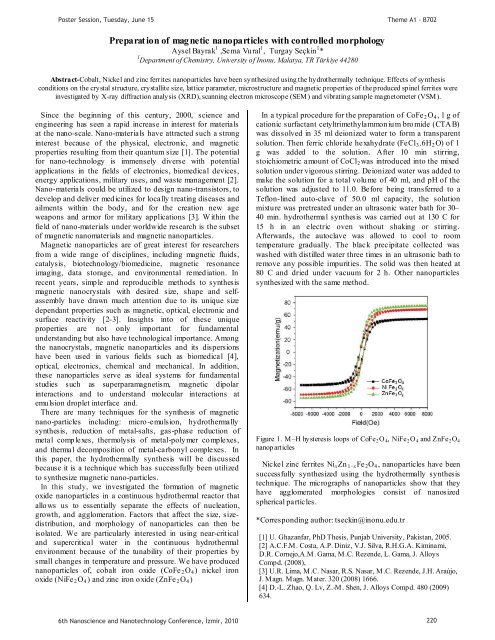Photonic crystals in biology
Photonic crystals in biology
Photonic crystals in biology
You also want an ePaper? Increase the reach of your titles
YUMPU automatically turns print PDFs into web optimized ePapers that Google loves.
Poster Session, Tuesday, June 15<br />
Theme A1 - B702<br />
Preparat ion of mag netic nanoparticles with controlled morphology<br />
Aysel Bayrak 1 ,Sema Vural 1 , Turgay Seçk<strong>in</strong> 1 *<br />
1 Department of Chemistry, University of Inonu, Malatya, TR Türkiye 44280<br />
Abstract-Cobalt, Nickel and z<strong>in</strong>c ferrites nanoparticles have been synthesized us<strong>in</strong>g the hydrothermally technique. Effects of synthesis<br />
conditions on the crystal structure, crystallite size, lattice parameter, microstructure and magnetic properties of the produced sp<strong>in</strong>el ferrites were<br />
<strong>in</strong>vestigated by X-ray diffraction analysis (XRD), scann<strong>in</strong>g electron microscope (SEM) and vibrat<strong>in</strong>g sample magnetometer (VSM).<br />
S<strong>in</strong>ce the beg<strong>in</strong>n<strong>in</strong>g of this century, 2000, science and<br />
eng<strong>in</strong>eer<strong>in</strong>g has seen a rapid <strong>in</strong>crease <strong>in</strong> <strong>in</strong>terest for materials<br />
at the nano-scale. Nano-materials have attracted such a strong<br />
<strong>in</strong>terest because of the physical, electronic, and magnetic<br />
properties result<strong>in</strong>g from their quantum size [1]. The potential<br />
for nano-technology is immensely diverse with potential<br />
applications <strong>in</strong> the fields of electronics, biomedical devices,<br />
energy applications, military uses, and waste management [2].<br />
Nano-materials could be utilized to design nano-transistors, to<br />
develop and deliver medic<strong>in</strong>es for locally treat<strong>in</strong>g diseases and<br />
ailments with<strong>in</strong> the body, and for the creation new age<br />
weapons and armor for military applications [3]. With<strong>in</strong> the<br />
field of nano-materials under worldwide research is the subset<br />
of magnetic nanomaterials and magnetic nanoparticles.<br />
Magnetic nanoparticles are of great <strong>in</strong>terest for researchers<br />
from a wide range of discipl<strong>in</strong>es, <strong>in</strong>clud<strong>in</strong>g magnetic fluids,<br />
catalysis, biotechnology/biomedic<strong>in</strong>e, magnetic resonance<br />
imag<strong>in</strong>g, data storage, and environmental remediation. In<br />
recent years, simple and reproducible methods to synthesis<br />
magnetic nano<strong>crystals</strong> with desired size, shape and selfassembly<br />
have drawn much attention due to its unique size<br />
dependant properties such as magnetic, optical, electronic and<br />
surface reactivity [2-3]. Insights <strong>in</strong>to of these unique<br />
properties are not only important for fundamental<br />
understand<strong>in</strong>g but also have technological importance. Among<br />
the nano<strong>crystals</strong>, magnetic nanoparticles and its dispersions<br />
have been used <strong>in</strong> various fields such as biomedical [4],<br />
optical, electronics, chemical and mechanical. In addition,<br />
these nanoparticles serve as ideal systems for fundamental<br />
studies such as superparamagnetism, magnetic dipolar<br />
<strong>in</strong>teractions and to understand molecular <strong>in</strong>teractions at<br />
emulsion droplet <strong>in</strong>terface and.<br />
There are many techniques for the synthesis of magnetic<br />
nano-particles <strong>in</strong>clud<strong>in</strong>g: micro-emulsion, hydrothermally<br />
synthesis, reduction of metal-salts, gas-phase reduction of<br />
meta l comp le xes, thermolysis of metal-poly mer co mple xes,<br />
and thermal decomposition of metal-carbonyl complexes. In<br />
this paper, the hydrothermally synthesis will be discussed<br />
because it is a technique which has successfully been utilized<br />
to synthesize magnetic nano-particles.<br />
In this study, we <strong>in</strong>vestigated the formation of magnetic<br />
oxide nanoparticles <strong>in</strong> a cont<strong>in</strong>uous hydrothermal reactor that<br />
allows us to essentially separate the effects of nucleation,<br />
growth, and agglomeration. Factors that affect the size, sizedistribution,<br />
and morphology of nanoparticles can then be<br />
isolated. We are particularly <strong>in</strong>terested <strong>in</strong> us<strong>in</strong>g near-crit ical<br />
and supercritical water <strong>in</strong> the cont<strong>in</strong>uous hydrothermal<br />
environment because of the tunability of their properties by<br />
small changes <strong>in</strong> temperature and pressure. We have produced<br />
nanoparticles of, cobalt iron oxide (CoFe 2 O 4 ) nickel iron<br />
oxide (NiFe 2 O 4 ) and z<strong>in</strong>c iron oxide (ZnFe 2 O 4 )<br />
In a typical procedure for the preparation of CoFe 2 O 4 , 1 g of<br />
cationic surfactant cetyltrimethylammonium bromide (CTAB)<br />
was dissolved <strong>in</strong> 35 ml deionized water to form a transparent<br />
solution. Then ferric chloride hexahydrate (FeCl 3 .6H 2 O) of 1<br />
g was added to the solution. After 10 m<strong>in</strong> stirr<strong>in</strong>g,<br />
stoichiometric amount of CoCl 2 was <strong>in</strong>troduced <strong>in</strong>to the mixed<br />
solution under vigorous stirr<strong>in</strong>g. Deionized water was added to<br />
make the solution for a total volume of 40 ml, and pH of the<br />
solution was adjusted to 11.0. Before be<strong>in</strong>g transferred to a<br />
Teflon-l<strong>in</strong>ed auto-clave of 50.0 ml capacity, the solution<br />
mixture was pretreated under an ultrasonic water bath for 30–<br />
40 m<strong>in</strong>. hydrothermal synthesis was carried out at 130 C for<br />
15 h <strong>in</strong> an electric oven without shak<strong>in</strong>g or stirr<strong>in</strong>g.<br />
Afterwards, the autoclave was allowed to cool to room<br />
temperature gradually. The black precipitate collected was<br />
washed with distilled water three times <strong>in</strong> an ultrasonic bath to<br />
remove any possible impurit ies. The solid was then heated at<br />
80 C and dried under vacuum for 2 h. Other nanoparticles<br />
synthesized with the same method.<br />
Figure 1. M–H hysteresis loops of CoFe 2 O 4 ,NiFe 2 O 4 and ZnFe 2 O 4<br />
nanop articles<br />
Nickel z<strong>in</strong>c ferrites Ni x Zn 1x Fe 2 O 4 , nanoparticles have been<br />
successfully synthesized us<strong>in</strong>g the hydrothermally synthesis<br />
technique. The micrographs of nanoparticles show that they<br />
have agglomerated morphologies consist of nanosized<br />
spherical particles.<br />
*Correspond<strong>in</strong>g author: tseck<strong>in</strong>@<strong>in</strong>onu.edu.tr<br />
[1] U. Ghazanfar, PhD Thesis, Punjab University, Pakistan, 2005.<br />
[2] A.C.F.M. Costa, A.P. D<strong>in</strong>iz, V.J. Silva, R.H.G.A. Kim<strong>in</strong>ami,<br />
D.R. Cornejo,A.M. Gama, M.C. Rezende, L. Gama, J. Alloys<br />
Compd. (2008),<br />
[3] U.R. Lima, M .C. Nasar, R.S. Nasar, M.C. Rezende, J.H. Araújo,<br />
J. Magn. Magn. Mater. 320 (2008) 1666.<br />
[4] D.-L. Zhao, Q. Lv, Z.-M. Shen, J. Alloys Compd. 480 (2009)<br />
634.<br />
6th Nanoscience and Nanotechnology Conference, zmir, 2010 220













